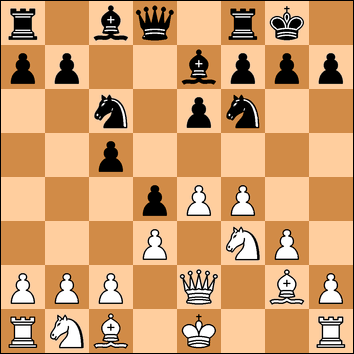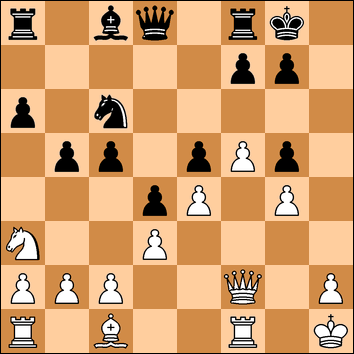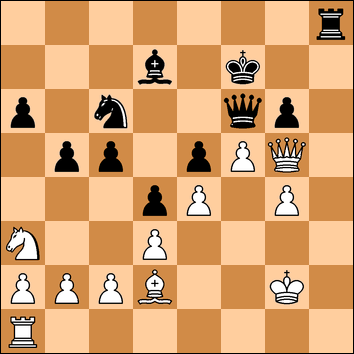Harvey- Rainham v Swale - Board One
Wednesday 9 January 2019
White: Keith Nevols (163) - Black: Robert Springett (134)
French Defence
1. e4 e6
2. Qe2 Be7
To allow d5 to be played next move - so I quickly move to the closed Sicilian.
3. Nc3 c5
3. .. d5 4. exd5 exd5 5. d4 is harmless for both sides.
4. f4 d5
5. Nf3 Nf6
I had planned to meet 5. .. dxe4 with 6. Nxe4 although 6. Qxe4 Nf6 7. Bb5+ (7. .. Kf8!?) could be interesting.
6. g3 Nc6
The engine likes 6. .. Nd4 7. Qf2 Nxf3 8. Qxf3 d4 9. Nd1/Nb1 O-O with Black comfortable and White still virtually at home.
7. d3 O-O
8. Bg2 d4
9. Nb1
This is always my plan, to re-route the knight via a3 or d2.

9. .. Qc7
9. ... Qa5+! puts early pressure on the White position. If 10. Nd2 then Nb4 11. Qd1 Ng4 will win material, but 11. O-O! will hold and Black can decide if he wants to risk 11. .. Nxa2!? (not 11. .. Nxc2 12. Nc4). Or 10. Bd2 Qb6 11. b3 Nb4 and White is getting tied up in knots. Maybe 10. Kf1 is safest.
10. O-O e5
11. f5
I put a lot of thought into 11. fxe5 Nxe5 12. Nxe5 Qxe5 13. Bf4 but Black has 13. .. Bg4! 14. Bf3 Qe6 which is just equal. Also 12. Bf4 Bd6 and again there is not much there.
So instead 11. f5 closes up the position and I can see if I can get a kingside attack going.
11. ... h6
I thought this might be a slight inaccuracy, weakening the pawns in front of the king and inviting g4-g5.
12. Na3
This knight is eager to get in the game - but instead it spectates for a while.
12. ..... a6
13. Bh3?!
I wanted to play g4 but could not think of the best way to support it. I considered 13. h3 but was worried about 13. ... Nh5 when I could not decide between 14. Qf2 or 14. Kh2. In any event I did not want the Black knight on h5 when I am playing g4. So instead it was 13. Bh3 with the option should I think about it or Qg2.
13. Nc4 Nd7 14. a4 was a line I did not consider but is better as it ties Black up slightly.
13. .... b5
While he was thinking I suddenly saw 13. .. g5! - the loose bishop on h3 making the en passant capture not possible.
14. g4 just looked silly and so maybe White has to admit the error and play 14. Bg2 but then ideas like h3-Nh2-Ng4 or Kf2-Rh1-h4 seem very slow.
14. g4 just looked silly and so maybe White has to admit the error and play 14. Bg2 but then ideas like h3-Nh2-Ng4 or Kf2-Rh1-h4 seem very slow.
13. .. b5 cuts off the knight. The engine prefers a calm 13. .. Bd7.
14. g4
And they're off.
14. ..... Nh7
15. Qf2 Qd8
Bolstering the g5 square.
16. Kh1
Freeing the g1 square for the forthcoming manoeuvre.
16. ..... Ng5
17. Ng1 Nxh3
18. Nxh3 Bg5?!
18. .... Bh4 might be a pain. But this is an inaccuracy as Black has to capture on g5 with a pawn.
19. Nxg5 hxg5

20. h4!?
I liked this move, with the plan 20. .. gxh4 21. g5, but Black can react with 21. .. g6!, using the time that White will waste to pick up the pawn to launch a counterattack himself.
22. Qxh4 gxf5 23. exf5 Ne7, not only hitting the pawn on f5 but opening that dangerous long diagonal towards the White king.
22. Qxh4 gxf5 23. exf5 Ne7, not only hitting the pawn on f5 but opening that dangerous long diagonal towards the White king.
20. ..... f6
Fortunately Black allows another weakness.
21. hxg5 fxg5
So although material is equal, Black has doubled and isolated g-pawns and White has some options to attack down the h-file and on the white squares.
22. Kg2?!
I saw the option to take the g-pawn with 22. Qd2 but wanted to see if I could make anything of the h-file, as I was not sure if I could win without the queens. However, Black could now play 22. .. g6.
22. ..... Qf6
The black move I now feared was Nc6-d8-f7, where on f7 the knight does a great defensive job, guarding some vital squares.
I gave thought to 23. Rh1 but after 23. .. Nd8 decided it was too slow, so I changed my mind and decided to bag the pawn.
I gave thought to 23. Rh1 but after 23. .. Nd8 decided it was too slow, so I changed my mind and decided to bag the pawn.
23. Qd2 Kf7
23. ... Be6!? exploiting the f-file pin would have been interesting, with 24. Qxg5 Bf7. Instead Black is trying to contest the h-file so I get there first.
24. Rh1 Bd7
25. Qxg5 Rh8
26. Bd2
A line here is 26. .. Qxg5 27. Bxg5 Rxh1 28. Rxh1 Nb4!? and a question as to what to do with the a2 pawn. 29. Ra1 is just silly, so maybe 29. Bd2 Nxa2 30. c3 dxc3 31. bxc3 and the game will revolve over whether White can round up the knight or whether Black can rescue it.
26. ...... Rag8
I did not understand this move though.
27. Rxh8 Rxh8

28. Rh1?
28. Qxf6+ Kxf6 29. c3! is better, heading for the endgame with the initiative. This move throws that away.
28. .... Rxh1
29. Kxh1 Qxg5
30. Bxg5 Nb4
And here Black offered a draw. Although my attack has died out, I am still a pawn up, so decided to play on.
31. Bd8 Nxa2
32. Bb6?
32. Bc7 Kf6 33. g5+! Kxg5 34. Bxe5 keeps White on top. Now Black has enough play for the draw - or even win. After all, look where the kings are!
32. .... c4
33. dxc4 bxc4??
At the board I thought 33. ... b4 was good with 34. Nb1 Ba4 - but also there is 33. .. Bc6 threatening the e4 pawn with check.
Fortunately for me, short of time, Black blunders.
34. Nxc4 Ke7
35. Nxe5 Nb4
36. Bc5+
Black now resigned. He had defended well but not taken the opportunities that my mistakes had presented him.
Robert Springett (134) 0-1 Keith Nevols (163)
Constantine Tucker (130) 0-1 Rob Woolacott (132)
Stephen Pike (128) 1-0 Tyrone Jefferies (119)
Gary Clifford (109) 0-1 Vytautas Gedminas (116)
Aditi Agarwal 1-0 Andrew Gillard (113)
Joe Pay (75) 1/2-1/2 Anthony Fletcher (86)
Rainham 2.5-3.5 Swale
No comments:
Post a Comment